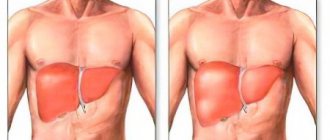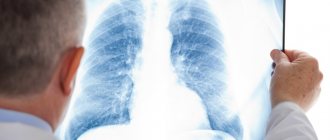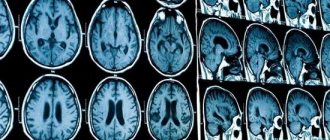Gastroenterologist
Neronov
Vladimir Alexandrovich
23 years of experience
Gastroenterologist, Doctor of Medical Sciences
Make an appointment
The result of almost any inflammatory processes in the liver tissue is liver fibrosis - the process of replacing hepatocytes with connective tissue, leading to the development of liver failure and a number of other severe pathologies. The proliferation of connective tissue can be local or diffuse, but in any case, in the early stages the process occurs without clinical manifestations and can only be detected by histological examination. Fibrous growths are characteristic of almost all chronic diseases of the organ, but with fatty steatosis they develop in only half of the patients, while alcoholic and viral lesions inevitably lead to the replacement of dying main liver cells with fibroblasts.
What is liver fibrosis
Liver fibrosis is scarring of the tissue.
The liver is capable of healing itself, however, this system does not work at full capacity if the liver is damaged or the injury is long-term and very serious. All attempts at regeneration cause an accumulation of connective tissue (these are tough, inert fibers) instead of functioning liver cells. Liver fibrosis is not a specific disease, but rather a symptom of another liver problem. The most common conditions that lead to liver fibrosis are alcoholism, chronic hepatitis C and non-alcoholic fatty liver disease (NAFLD).
Liver fibrosis itself does not cause any symptoms. Doctors can detect signs of liver fibrosis using blood tests and an ultrasound, CT scan, or MRI. If it is detected early, it can be treated. But if it goes undetected and damage continues, fibrosis can progress to cirrhosis.
Effective therapy
Currently, there are no techniques that would force connective tissue to resolve with the restoration of parenchyma. Treatment of liver fibrosis is aimed at slowing down or completely stopping the pathological process. The efforts of doctors are aimed at:
- eliminating the causes that caused the proliferation of connective tissue - prescribing antiviral or anthelmintic drugs;
- taking anti-inflammatory drugs;
- reduction of portal hypertension, restoration of blood circulation;
- increased sensitivity to insulin in fatty hepatosis.
The basis of treatment, as a rule, is the use of hepatoprotectors, adherence to a diet that relieves the liver, complete cessation of alcohol and smoking, and weight correction. If clinical recommendations are followed, the treatment prognosis is quite favorable.
Degrees of liver fibrosis in adults
Experts distinguish 5 degrees of scarring of liver tissue.
No fibrosis.
In this case, there is no evidence of liver cell death (necrosis) or scarring, despite liver inflammation (hepatitis).
Portal (mild) fibrosis.
In this case, there are areas of necrosis and scarring affecting the small and medium branches of the portal vein, which carries blood from the small intestine. The structure and function of the liver remain normal.
Periportal (moderate) fibrosis.
This is an option with an increase in foci of necrosis, scarring and impaired liver function.
Bridging (severe) fibrosis.
At this stage, scarring has disrupted normal blood flow to the liver and function is further impaired.
Cirrhosis.
This is permanent scarring and irreversible loss of liver function.
Types of disease
Depending on the location of fibrotic growths, the following forms are distinguished:
- Venular. Scar fibers are noted in the central sections of the organ lobules.
- Pericellular. Connective tissue constrictions are detected around cellular structures.
- Septal. An unfavorable option, which is characterized by necrosis of large areas of liver tissue. The septa (septa) formed at the sites of necrosis change the structure of the organ.
- Periductal. Conical scar structures grow around the bile ducts.
Causes of liver fibrosis in adults
Fibrosis can occur in cases where the liver is severely damaged or suffers from chronic or severe injury.
As the liver tries to repair itself by creating new cells, it cannot do so fully and scars form. Dead liver cells are replaced with fibrous tissue. This tissue eventually interferes with the normal functioning of the liver. Liver fibrosis is a symptom of several underlying diseases. The most common reasons are:
Alcoholism.
The liver breaks down alcohol and removes harmful byproducts that damage liver cells. But the more alcohol she has to dispose of, the more damaged she is - she simply cannot cope with large volumes of toxins.
Chronic hepatitis C.
Hepatitis C virus (HCV) attacks the liver, causing damage and inflammation. Most people have no symptoms for several years after infection. As a result, liver problems, including fibrosis, are common at the time of diagnosis. Fortunately, there are effective treatments.
Non-alcoholic fatty liver disease.
This is a buildup of fat in the liver that can cause inflammation and damage, leading to fibrosis. The disease is not associated with alcohol consumption. But it often occurs in people with obesity and type 2 diabetes.
Other potential underlying causes of liver fibrosis include blocked bile ducts, autoimmune diseases, inherited metabolic disorders, conditions that cause decreased blood flow to the liver, and certain medications (amiodarone, corticosteroids, isoniazid, methotrexate, and methyldopa).
There is also a congenital form of liver fibrosis that is present at birth.
Diagnostic methods
During a medical examination, the disease can be detected only in the last stages of the development of the process. Clinical studies are much more informative:
- CBC is a general blood test, which shows a decreased level of hemoglobin and red blood cells with an increased ESR;
- OAM is a general analysis that detects the presence of protein, casts and bilirubin;
- blood - biochemical analysis that detects an increase in all indicators related to the liver;
- Ultrasound of the liver - reveals an increase in the size of the organ and the appearance of fibrotic formations;
- elastometry - to assess the structure of the liver and the elasticity of its tissues;
- tomography - to determine the number of fibrous foci, from localization and quality indicators.
To accurately diagnose liver fibrosis, a biopsy may be necessary. It is performed under the control of ultrasound equipment by inserting a special trepanation needle. If there are contraindications to the procedure, a diagnosis can be made based on elastometry data.
Symptoms of liver fibrosis in adults
Scarring from liver fibrosis can affect the liver's ability to function effectively.
However, fibrosis itself does not cause any symptoms. You may have it and not know it. If fibrosis progresses to cirrhosis, the main symptoms may include:
- constant bruises on the body and bleeding;
- fatigue, confusion and weakness;
- itching;
- poor appetite, nausea and weight loss;
- swelling of the abdomen (ascites) and legs (pasty);
- yellowing of the skin and eyes (jaundice).
Liver cirrhosis is a serious disease that can lead to life-threatening complications. Seek medical help immediately if you experience the above symptoms.
Stages of the disease
Based on the results of a biopsy (histological examination of liver tissue under a microscope), the severity of fibrosis is assessed.
To do this, use a scale for assessing the severity of liver fibrosis - the Metavir5 system:
No fibrosis
Widening of the portal tracts, but without the formation of septa
Expansion of portal tracts with single porto-portal septa
Porto-portal and porto-central septa
Cirrhosis of the liver
However, this diagnostic method has a number of disadvantages5: it is an invasive method that is not indicated for every patient with liver fibrosis. Moreover, performing a biopsy is associated with a high risk of complications from bleeding to accidental damage to neighboring organs, such as the gallbladder, etc.
What methods of diagnosing fibrosis can be used in almost every patient?
Popular questions and answers
We asked gastroenterologist Valeria Lomova to answer popular questions about liver fibrosis.
Why is liver fibrosis dangerous?
The danger of fibrosis lies in the fact that it does not manifest itself in any way for a long time - the patient does not report complaints and does not seek help from a medical institution. In this case, fibrosis can progress, and all liver functions are disrupted, which leads to disaster throughout the body.
Who is most likely to have liver fibrosis?
At risk are:
- patients with viral hepatitis B and C;
- patients who have been drinking alcohol in hepatotoxic doses for more than 5 years;
- people suffering from obesity, autoimmune liver diseases, and storage diseases (hemochromatosis, Wilson's disease).
The development of liver fibrosis is also possible due to the toxic effects of certain groups of drugs.
Can fibrosis be cured completely?
Fibrosis regression is possible at all stages. But if it turns into cirrhosis, this is already the point of no return.
What complications can occur with liver fibrosis?
With long-term liver fibrosis, liver cirrhosis can develop, in which healthy connective tissue is completely replaced with disruption of all liver functions, which can lead to death.
If left untreated
Ignoring the disease is a movement in the direction of cirrhosis, ascites, internal bleeding, and malignant neoplasms. These diseases should not be joked about. Thousands of people die because of them every year.
If you suffer from alcoholism and feel pain in the right hypochondrium
, stop and think: where will you go? Don't risk your health. Make an appointment with a narcologist and get coded, and then undergo effective treatment for fibrosis under the supervision of a hepatologist.
Complications
In the absence of timely treatment, second-degree fibrosis can lead to the development of serious complications and negative consequences.
- Complication of fibrosis and transition from early stages of the disease to later ones, development of cirrhosis.
- Accumulation of a large amount of fluid and the development of inflammation in the abdominal cavity.
- Significant dilation of the esophageal veins, venous bleeding.
- Disorders of consciousness accompanied by disturbances in muscle function.
- Development of liver tumor (carcinoma).
- Severe renal failure.
- The development of diseases of organs affected as a result of disturbances in the liver (deviations in the functioning of the stomach, intestines, anemia, infertility).
Traditional medicine
If liver fibrosis is treated comprehensively, then in this case, along with drug treatment, therapy using traditional medicine is indicated. Non-drug treatment is also indicated during the period of remission to reduce the likelihood of relapses. The following treatment methods are used:
To improve the flow of bile and strengthen the immune system, use a tincture made from ground milk thistle seeds. This drug has a hepatoprotective effect. To inhibit the growth of fibrous tissues, a tincture of white cinquefoil is used. To do this, ten grams of dry grass roots are mixed with one hundred milliliters of vodka and allowed to brew for thirty days. After this, the product is used twice a day, twenty to thirty drops, washed down with water.
Important! It is not recommended to use alcohol-containing tinctures in the treatment of liver fibrosis when the disease is caused by alcoholic hepatitis.
A choleretic and immunomodulatory effect can be achieved using a decoction of rose hips.
To prepare the decoction, the fruits are poured with hot water and infused in a thermos overnight. Use a couple of tablespoons three times a day. To obtain a choleretic effect, use a decoction of corn silk. This remedy has an anti-inflammatory effect and is indicated for pathological stagnation of bile. The decoction helps dissolve stones. Olive oil also has a choleretic effect. It is especially effective to use oil in combination with honey, mixing the components in equal parts. It is worth understanding that this kind of cleansing does not affect the process of scarring in the liver, but rather helps eliminate the accompanying symptoms.










